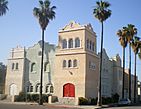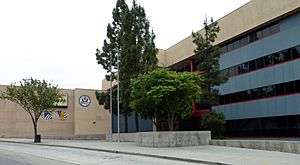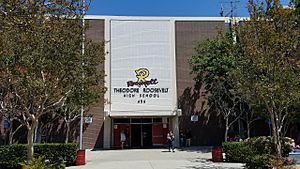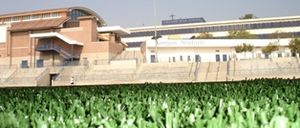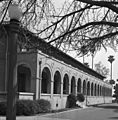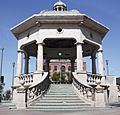Boyle Heights, Los Angeles facts for kids
Quick facts for kids
Boyle Heights
|
|
|---|---|
|
Top: Mariachi Plaza; St. Mary's Church; bottom: Calvary Church; LAC+USC Medical Center.
|
|
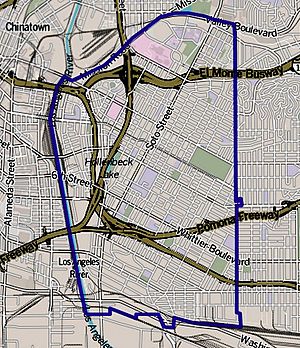
Boundaries of Boyle Heights
as drawn by the Los Angeles Times |
|
| Country | |
| State | |
| County | Los Angeles |
| City | Los Angeles |
| Area | |
| • Total | 17 km2 (6.5 sq mi) |
| Population
(2000)
|
|
| • Total | 92,785 |
| • Density | 5,507/km2 (14,262/sq mi) |
| ZIP Codes |
90023, 90033, 90063
|
| Area code(s) | 213/323 |
Boyle Heights, historically known as Paredón Blanco, is a neighborhood in Los Angeles, California, located east of the Los Angeles River. It is one of the city's most notable and historic Chicano/Mexican-American communities and is known as a bastion of Chicano culture, hosting cultural landmarks like Mariachi Plaza and events like the annual Día de los Muertos celebrations.
Contents
History
Boyle Heights was called Paredon Blanco (White Bluff) when California was part of Mexico.

and Los Angeles city in the background
Population
In the 1950s, Boyle Heights was racially and ethnically diverse, with Jews, Latinos (mainly Chicanos), various sectarian Spiritual Christians from Russia, Yugoslav (Serbian and Croatian) immigrants, Portuguese people, and Japanese Americans living in the neighborhood. Bruce Phillips, a sociologist who tracked Jewish communities across the United States, said that Jewish families left Boyle Heights not because of racism, but instead because of banks redlining the neighborhood (denying home loans) and the construction of several freeways through the community, which led to the loss of many houses.
As of the 2000 census, there were 92,785 people in the neighborhood, which was considered "not especially diverse" ethnically, with the racial composition of the neighborhood at 94.0% Latino, 2.3% Asian, 2.0% White (non-Hispanic), 0.9% African American, and 0.8% other races. The median household income was $33,235, low in comparison to the rest of the city. The neighborhood's population was also one of the youngest in the city, with a median age of just 25.
As of 2011, 95% of the community was Hispanic and Latino. The community had Mexican Americans, Mexican immigrants, and Central American ethnic residents. Hector Tobar of the Los Angeles Times said, "The diversity that exists in Boyle Heights today is exclusively Latino".
Latino communities These were the ten cities or neighborhoods in Los Angeles County with the largest percentage of Latino residents, according to the 2000 census:
- East Los Angeles, California, 96.7%
- Maywood, California, 96.4%
- Walnut Park, California, 95.4%
- Huntington Park, California, 95.1%
- Boyle Heights, Los Angeles, 94.0%
- Cudahy, California, 93.8%
- Bell Gardens, California, 93.7%
- Commerce, California 93.4%
- Vernon, California, 92.6%
- South Gate, California, 92.1%
Latino political influence
The emergence of Latino politics in Boyle Heights influenced the diversity in the community. First and foremost, Boyle Heights was a predominantly Jewish community with “a vibrant, pre-World War II, Yiddish-speaking community, replete with small shops along Brooklyn Avenue, union halls, synagogues and hyperactive politics … shaped by the enduring influence of the Socialist and Communist parties” (Burt, 22) before Boyle Heights became predominantly associated with Mexicans/Mexican Americans. The rise of the socialist and communist parties increased the people’s involvement in politics in the community because the “liberal-left exercised great influence in the immigrant community” (Burt, 22-23). Even with an ever-growing diversity in Boyle Heights, “Jews remained culturally and politically dominant after World War II”(Burt, 23). However, as the Jewish community was moving westward into new homes, the largest growing group, Latinos, were moving into Boyle Heights because to them this neighborhood was represented as upward mobility. With Jews and Latinos both in Boyle Heights, these men part of the Jewish Community Relations Council (JCRC); Louis Levy, Ben Solnit, Pinkhas Karl, Harry Sheer, and Julius Levitt helped to empower the Latinos who either lived among the Jewish people or who worked together in the factories. The combination of Jewish people and Latinos in Boyle Heights symbolized a tight unity between the two communities. The two races helped each other in order to elect Roybal into city council against his opponent Councilman Christensen; with the help from the Community Service Organization (CSO). In order for Roybal to win a landslide victory over Christensen, “the JCRC, with representation from business and labor leaders, associated with both Jewish left traditions, had become the prime financial benefactor to CSO … labor historically backed incumbents … [and] the Cold War struggle for the hearts and minds of minority workers also influenced the larger political dynamic”(Burt, 26).
In the 1947 election, Roybal lost and then Saul Alinsky; well-known Chicago-Jewish community activist and his company, the Industrial Areas Foundation (IAF) garnered support from the Mexican Americans in order for Roybal to win the 1949 election(Bernstein, 243). When Edward Roybal had just started as the city of Los Angeles’ new city councilman in 1949, he experienced racism when trying to buy a home for his family. The real estate agent told him that he could not sell to Mexicans, and from then on Roybal’s first act as councilman was to protest racial discrimination and to create a community that represented inter-racial politics in Boyle Heights. The Community Service Organization (CSO) helped Roybal win the election and to increase the multi-racial involvement in Boyle Heights(Bernstein, 224). Therefore, Roybal’s involvement in City Council affected how Latino politics went further on during Bradley’s term and for future political leaders coming from Boyle Heights.
This Latino-Jewish relationship shaped politics because when Mayor Villaraigosa became mayor of Los Angeles in 2005, and “not only did he have ties to Boyle Heights, but he was elected by replicating the labor-based, multicultural coalition that Congressman Edward Roybal assembled in 1949 to become Los Angeles’s first city council member of Latino heritage”(Burt, 23). Furthermore, the Vladeck Center (named after Borukh Charney Vladeck) contributed to the community of Boyle Heights in a big way because it was not just a building, it was “a venue for a wide range of activities that promoted Jewish culture and politics”(Burt, 22). This center will be forever known as the building place where coalition politics took place in Boyle Heights, along with the Catholic Dolores Mission center.
Geography
Boyle Heights' relation to other places, not necessarily contiguous:
 |
Brooklyn Heights, Los Angeles |
|
|||||
| Arts District, Los Angeles | East Los Angeles, California | ||||||
| Vernon, California | Commerce, California |
Notable places
Existing
- Breed Street Shul, which was declared a historic-cultural monument in 1988.
- Self-Help Graphics and Art, the first community-based organization in the country to create a free public celebration of Day of the Dead.
- Los Angeles County+USC Medical Center/Keck School of Medicine of USC
- Los Angeles County Department of Coroner
- Estrada Courts Murals
- Evergreen Cemetery
- Hazard Park
- Mariachi Plaza
- Hollenbeck Park
- Linda Vista Community Hospital (former Santa Fe Coast Lines Hospital)
- Sears Building, Olympic Boulevard and Soto St.
- Malabar Public Library
- Lucha Underground Temple, where the television program Lucha Underground is taped.
Demolished
- Soto-Michigan Jewish Community Center
- Aliso Village
- Sisters Orphan Home, operated by Daughters of Charity of Saint Vincent de Paul, 917 S. Boyle Ave. demolished due to earthquake damage and construction of freeway.
Demographics
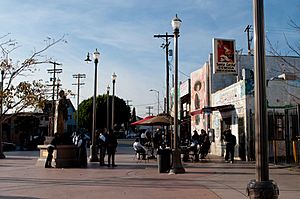
As of the 2000 census, there were 92,785 people in the neighborhood, which was considered "not especially diverse" ethnically, with the racial composition of the neighborhood at 94.0% Latino, 2.3% Asian, 2.0% White (non-Hispanic), 0.9% African American, and 0.8% other races. The median household income was $33,235, low in comparison to the rest of the city. The neighborhood's population was also one of the youngest in the city, with a median age of just 25.
As of 2011, 95% of the community was Hispanic and Latino. The community had Mexican Americans, Mexican immigrants, and Central American ethnic residents. Hector Tobar of the Los Angeles Times said, "The diversity that exists in Boyle Heights today is exclusively Latino".
Latino communities These were the ten cities or neighborhoods in Los Angeles County with the largest percentage of Latino residents, according to the 2000 census:
- East Los Angeles, California, 96.7%
- Maywood, California, 96.4%
- Walnut Park, California, 95.4%
- Huntington Park, California, 95.1%
- Boyle Heights, Los Angeles, 94.0%
- Cudahy, California, 93.8%
- Bell Gardens, California, 93.7%
- Commerce, California 93.4%
- Vernon, California, 92.6%
- South Gate, California, 92.1%
Education
Just 5% of Boyle Heights residents aged 25 and older had earned a four-year degree by 2000, a low percentage for the city and the county. The percentage of residents in that age range who had not earned a high school diploma was high for the county.
Public
- Francisco Bravo Medical Magnet High School, alternative, 1200 North Cornwell Street
- Theodore Roosevelt High School, 456 South Mathews Street
- Mendez High School 1200 Playa Del Sol
- Animo Oscar De La Hoya Charter High School, 1114 South Lorena Street
- Boyle Heights Continuation School, 544 South Mathews Street* Central Juvenile Hall, 1605 Eastlake Avenue
- Hollenbeck Middle School, 2510 East Sixth Street
- Robert Louis Stevenson Middle School, 725 South Indiana Street
- KIPP Los Angeles College Preparatory, charter middle, 2810 Whittier Boulevard
- Murchison Street Elementary School, 1501 Murchison Street
- Evergreen Avenue Elementary School, 2730 Ganahl Street
- Sheridan Street Elementary School, 416 North Cornwell Street
- Malabar Street Elementary School, 3200 East Malabar Street
- Breed Street Elementary School, 2226 East Third Street
- First Street Elementary School, 2820 East First Street
- Second Street Elementary School, 1942 East Second Street
- Soto Street Elementary School, 1020 South Soto Street
- Euclid Avenue Elementary School, 806 Euclid Avenue
- Sunrise Elementary School, 2821 East Seventh Street
- Utah Street Elementary School, 255 Gabriel Garcia Marquez Street
- Bridge Street Elementary School, 605 North Boyle Avenue
- Garza (Carmen Lomas) Primary Center, elementary, 2750 East Hostetter Street
- Christopher Dena Elementary School, 1314 Dacotah Street
- Learning Works Charter School, 1916 East First Street
- Lorena Street Elementary School, 1015 South Lorena Street
- PUENTE Learning Center, 501 South Boyle Avenue
- East Los Angeles Occupational Center (Adult Education), 2100 Marengo Street
- Endeavor College Preparatory Charter School, 1263 S Soto St, Los Angeles, CA 90023
Private
- Bishop Mora Salesian High School, 960 South Soto Street
- Santa Teresita Elementary School, 2646 Zonal Avenue
- Assumption Elementary School, 3016 Winter Street
- Saint Mary Catholic Elementary School, 416 South Saint Louis Street
- Our Lady of Talpa, elementary, 411 South Evergreen Avenue
- East Los Angeles Light and Life Christian School, 207 South Dacotah Street
- Santa Isabel Elementary School, 2424 Whittier Boulevard
- Dolores Mission School, elementary, 170 South Gless Street
- Cristo Viene Christian School, 3607 Whittier Boulevard
- Resurrection, elementary, 3360 East Opal Street
- White Memorial Adventist School, 1605 New Jersey Street
- PUENTE Learning Center, 501 South Boyle Avenue
Notable people
Sports
- William Harmatz, jockey
- Ron Mix (born 1938), Football Hall of Famer
- Donald Sterling, Former Los Angeles Clippers owner
Arts and culture
- Oscar Zeta Acosta, attorney, writer, community activist
- Lou Adler, record producer, manager
- Herb Alpert
- Greg Boyle, Catholic priest, community activist
- Mickey Cohen, gangster
- Norman Granz
- Josefina López, writer
- Anthony Quinn, actor
- Andy Russell, international singing star
- Julius Shulman, photographer
- Taboo, rapper
- will.i.am, recording artist and music producer
Publishing
- Jack T. Chick, publisher of Chick tracts
Images for kids
-
Santa Fe Hospital in 1905 (modern day Linda Vista Community Hospital).
-
The Mission Revival style Hollenbeck Palms in 1956.
-
The Mariachi Plaza kiosko was a gift from the Mexican state of Jalisco to the people of Los Angeles.
-
Malabar Branch Library, built in 1927 in a Spanish Eclectic style.
See also
 In Spanish: Boyle Heights para niños
In Spanish: Boyle Heights para niños




